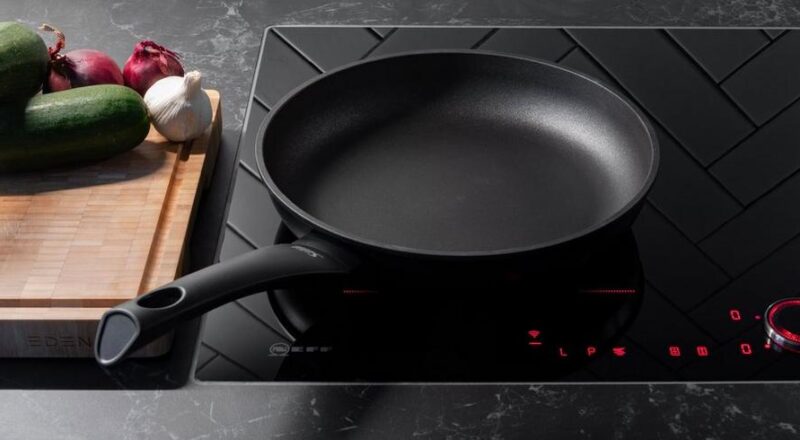In today’s fast-paced culinary world, the demand for efficient and versatile cookware is ever-growing. Among the array of kitchen essentials, induction friendly cast iron pans have carved a niche for themselves. These pans not only promise durability but also offer an unparalleled cooking experience, especially on induction cooktops. In this comprehensive guide, we will delve into the world of cast iron pans, highlighting their unique features, benefits, and tips to make the most of them.

What Makes a Pan Induction Friendly?
Before diving into the specifics of cast iron, it’s essential to understand what makes a pan suitable for induction cooking. Induction cooktops work by generating a magnetic field, which in turn heats the pan. For this process to be effective, the cookware must be made of or contain a magnetic material.
The Science Behind Induction Cooking
Induction cooking is both efficient and fast. Unlike traditional gas or electric cooktops, induction cooktops only heat the pan, not the entire surface. This feature not only saves energy but also reduces cooking time. Pans made of iron or steel are perfect for this method, as they respond well to magnetic fields.
Why Choose Cast Iron?
Cast iron has been a staple in kitchens for centuries. Its robustness, heat retention, and even cooking make it a favorite among chefs and home cooks alike. When combined with the efficiency of induction cooking, cast iron pans become an unbeatable choice for any kitchen.
Benefits of Using Cast Iron
- Durability: With proper care, cast iron pans can last a lifetime, making them a worthy investment.
- Versatility: From frying to baking, these pans can handle a variety of cooking methods.
- Even Heat Distribution: Cast iron ensures even cooking, eliminating hot spots and burning.
Top Features of Induction Friendly Cast Iron Pans
When selecting a cast iron pan for your induction cooktop, there are several features to consider:
Flat Base
A flat base ensures maximum contact with the cooktop, enhancing heat transfer and cooking efficiency.
Pre-Seasoned Surface
Many cast iron pans come pre-seasoned, providing a non-stick surface right out of the box. This feature not only simplifies cooking but also makes cleaning a breeze.
Maintaining Your Cast Iron Pan
Proper maintenance is crucial to ensure the longevity of your cast iron pan. Here are some tips:
Cleaning
Avoid using harsh detergents. Instead, opt for mild soap and water. For stubborn residues, a gentle scrub with a brush will suffice. For more cleaning tips, check out our cleaning hacks.
Seasoning
Regularly seasoning your pan helps maintain its non-stick surface. Simply coat it with a thin layer of oil and bake it in the oven at high temperatures.
Cooking Tips for Cast Iron
To get the best results from your cast iron pan, consider the following tips:
Preheating
Always preheat your cast iron pan before adding ingredients. This step ensures even cooking and enhances the flavors of your dish.
Avoiding Sticking
To prevent food from sticking, always use sufficient oil or fat. Additionally, ensure the pan is adequately seasoned.
Common Myths About Cast Iron
Despite their popularity, several myths surround cast iron cookware. Let’s debunk some of them:
Myth: Cast Iron is Hard to Maintain
While cast iron requires some care, it’s not as daunting as it seems. With simple cleaning and seasoning routines, maintenance becomes a breeze. For more detailed guidance, visit our manual cleaning tips.
Myth: Cast Iron Cant Be Used on Induction
This is far from the truth. In fact, cast iron is one of the best materials for induction cooking. Curious about how cast iron performs on induction? Check out this informative article.
Choosing the Right Cast Iron Pan
When selecting a cast iron pan, consider factors such as size, weight, and intended use. A well-chosen pan can significantly enhance your cooking experience.
Size Matters
Consider the number of people you typically cook for and the types of dishes you prepare. Larger pans are ideal for family meals, while smaller ones are perfect for individual servings.
Weight Considerations
While cast iron is inherently heavy, some pans are lighter than others. Choose a weight that you’re comfortable handling, especially if you plan on using the pan frequently.
Conclusion
In conclusion, induction friendly cast iron pans are a valuable addition to any kitchen. Their durability, versatility, and efficiency on induction cooktops make them a preferred choice for both amateur and professional cooks. By understanding their features and proper maintenance, you can elevate your cooking game and enjoy delicious meals every time.

FAQs
Can cast iron be used on induction cooktops?
Absolutely! Cast iron is perfect for induction cooktops due to its magnetic properties. For more insights, visit this external article.
How do I season my cast iron pan?
To season your pan, coat it with a thin layer of oil and bake it in the oven at high temperatures. This process helps maintain its non-stick surface.
Is cast iron suitable for all types of cooking?
Yes, cast iron is incredibly versatile. From frying to baking, it can handle a variety of cooking methods, making it a staple in any kitchen.
This article contains affiliate links. We may earn a commission at no extra cost to you.

